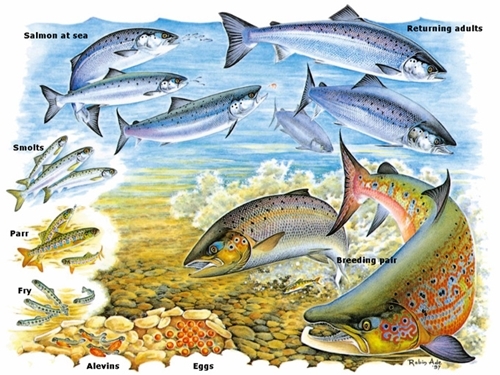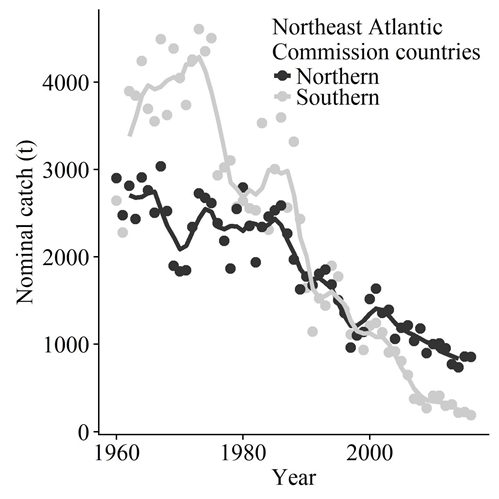Key points
- Salmon populations have been declining over the past 30 years.
- Salmon hatch in streams, migrate to the sea after 1-4 years, spend one or more years at sea, before travelling back to their home stream to spawn.
- When spawning they make nests in the gravel, called redds.
- The distribution of redds along the river course is affected by water flow through the River Frome.
- This may affect how successfully the young salmon grow and survive.
Background
Atlantic salmon have a complicated life cycle that involves several stages, which occur in different habitats. They hatch from eggs in freshwater streams and rivers where they grow and develop. They then travel downstream to the ocean, where they go to feed. Finally, they return to their home river to spawn the next generation. They are thought of as an indicator species – one that gives an idea of the overall health of an ecosystem. Rivers need to be clean and well-connected for salmon to thrive, and if they are not the local population will be lost. Atlantic salmon are the species you will recognise from the supermarket shelves, but now almost all salmon consumed are farmed, rather than wild.

Illustration courtesy of the Atlantic Salmon Trust and Robin Ade.
Female salmon use their tail to dig nests in the gravel river bed, called redds. The eggs are laid in redds in winter, and over the course of three months or more these develop into very small salmon called alevin. In the spring, the alevin swim out of the gravel and begin to eat small, water-living insects, at which point they are called fry. Fry grow larger and become camouflaged to suit their river environment, when they are called parr. These parr live and grow in the river for between one and four years, depending on the river, its temperature and the amount of prey available, until they are ready to ‘smoltify’, when they develop saltwater tolerance at around 15cm in size. This process involves a change in camouflage to suit the ocean environment, as well as changes in their body to allow them to cope with salt water.
The fish are now called smolts, and they travel downstream to the ocean, where they will live and grow for up to four years, until they are ready to return and spawn as adults themselves, now called spawners. At sea, salmon travel with the ocean currents and eat plankton, small fish and fish fry. Some return to the river they were hatched in after only one year at sea, and others stay at sea for a few years before they migrate back to their home rivers to breed. Salmon can repeat this cycle several times, travelling to the ocean and then back to their home rivers, but many repeats of the life cycle are rare, with most fish breeding only once or twice.
 Figure 1: Catches of Atlantic salmon have been declining for decades. In part, this reflects
Figure 1: Catches of Atlantic salmon have been declining for decades. In part, this reflects
reduced fishing effort, but the declines are thought to represent declines in stocks, even after
successive fishing quota restrictions.
Atlantic salmon populations have declined dramatically in the last 30 years, which is thought to be a result of habitat and climate changes. Identifying exact reasons for these population changes is challenging because of their complex life cycle that can be affected by many different factors, some of which we know of and measure, and some we don’t.
This study looked at salmon redds, and how their in-river location is affected by river flow. There are lots of factors that can affect redd site choice: they are ideally made in clean river gravel, and they need a good flow of water to provide oxygen to the eggs or alevin, which is critical for their survival. Redds near to deep pools or cover from plants can help emerged alevins and fry escape from predators, and the river temperature, depth, amount of water flow and sediment are also important.
What they did
 This study aimed to gather more knowledge about how river flow (the amount of water flowing through the river) affects the location of salmon redds in a British chalk stream, and how they are distributed throughout its length. The study was performed on the River Frome in Dorset, and looked at information on river flow and redd distribution from 1980 to 2015. Surveys of redds have been carried out consistently since 1980, in January or February each year. The river contains redds of both salmon and trout, and they were distinguished by their size – salmon being over 110cm wide and trout under, which were located by eye, as they can be seen using a polarised lens.
This study aimed to gather more knowledge about how river flow (the amount of water flowing through the river) affects the location of salmon redds in a British chalk stream, and how they are distributed throughout its length. The study was performed on the River Frome in Dorset, and looked at information on river flow and redd distribution from 1980 to 2015. Surveys of redds have been carried out consistently since 1980, in January or February each year. The river contains redds of both salmon and trout, and they were distinguished by their size – salmon being over 110cm wide and trout under, which were located by eye, as they can be seen using a polarised lens.
The flow of the River Frome has been monitored every 15 minutes by a monitoring station at East Stoke since 1965, by the Environment Agency. Flow is also studied at a monitoring station 20km upstream at Louds Mill, which confirms the results at East Stoke. The information from these flow stations was used by the scientists to calculate the average flow for October to December (the period immediately before spawning) each year, as well as the number of days in that time that had particularly high flow.
These two sets of data were used together to look at whether river flow affected where salmon redds were made in that year. Five statistical models were developed to characterise the effect of flow on salmon redd distribution, accounting for other factors, and the best of these was used to analyse the data.
What they found
River flow in late autumn did affect the distribution of redds along the river. When flow was low, there were more redds clustered together in the middle sections of the river, and fewer further upstream. When flow was high, the redds were more evenly distributed along the whole river, reaching further upstream.
This may have been because, when the water level is lower, obstacles in the river become harder to pass and the fish cannot access the upper reaches of the river (further from the sea) as easily for spawning. For example, salmon have been seen gathering below weirs on the River Frome, and these may be harder to pass when flow is low. Also, smaller streams feeding the Frome in the upper regions may become too shallow for spawning when the water level is lower or slower, so the salmon have to make their redds further downstream, in the mid-section of the Frome’s course.
What does this mean?
We know that young salmon suffer more predation when they are in higher densities – concentrated into a smaller area. When the redds are less well distributed along the river, the newly emerged fry also have to cope with more competition, which could lead to poorer survival or smaller smolts. These results show that this is more likely to be the case in years of low flow, so more predation could lead to worse survival in those years.

This study is also important for the future, because climate change is predicted to lead to more variation in rainfall, which is likely to cause more extreme events, including higher and lower river flows. This study suggests that this would more often lead to salmon redds concentrated together in the middle section of spawning rivers, and perhaps poorer outcomes for salmon spawning success. Extremely high flows can also damage redds, or excessive sediment deposits after flooding can clog up the gravel and reduce oxygen, which reduces the success of the spawning process. These are also likely to increase if climate change forecasts are correct. The findings of this study contribute towards salmon conservation in future, and may also be applied to conservation of other similar species.
Read the original abstract
Parry, E.S., Gregory, S.D., Lauridsen, R.B., & Griffiths, S.W. (2018). The effects of flow on Atlantic salmon (Salmo salar) redd distribution in a UK chalk stream between 1980 and 2015. Ecology of Freshwater Fish, 27: 128-137.
![4036-gwct -fisheries -supporters -badge -500-1-p [ekm ]693x 401[ekm] 4036-gwct -fisheries -supporters -badge -500-1-p [ekm ]693x 401[ekm]](/media/884168/4036-gwct-fisheries-supporters-badge-500-1-p-ekm-693x401-ekm-.jpg?width=500&height=289&crop=true)
Support our vital salmon research
You can help us understand what's driving the decline in Atlantic Salmon numbers by buying one of our salmon pewter pin badges.
£5 from the sale of each badge helps support our Salmon & Trout Research Centre at East Stoke in Dorset which monitors this decline using a fish counter which was first installed in 1973. It is one of the most comprehensive records of salmon movement in England and Wales.
Buy now >